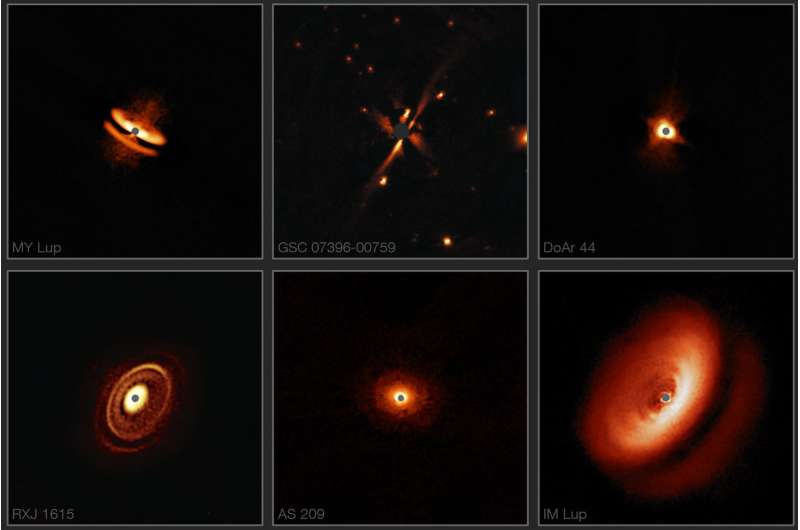An amazingly wide variety of planet-forming disks

With an instrument at the Very Large Telescope in Chile scientists of ETH Zurich observed planet-forming disks around young stars similar to the sun 4,5 billion years ago. Surprisingly, the disks are very different. The data will help to shed more light on the formation processes of planets.
An instrument, which was partially developed and built at ETH Zurich, has now been particularly successful at studying new born stars still surrounded by gas and dust. With SPHERE (Spectro-Polarimetric High-contrast Exoplanet REsearch) at the European Southern Observatory (ESO), astronomers of ETH Zurich and Max Planck Institute for Astronomy in Heidelberg were able to take images of planet-forming disks around the young stars: these disks, called protoplanetary disks, exist around so-called TTauri stars – the progenitors to our Sun – as well as around the more massive siblings called Herbig Ae/Be stars. So far astronomers focussed mostly on Herbig Ae/Be stars in their studies, but with a new, ambitious program called DARTTS-S (Disks Around TTauri Stars with SPHERE), Henning Avenhaus and Sascha Quanz, former and current members of the NCCR PlanetS at ETH Zurich, have now been able to use the capabilities of SPHERE to undertake a survey of TTauri disks.
The results for the first eight stars are released in a paper published by the Astronomical Journal. "Not only were we able to clearly detect all eight disks," summarizes Henning Avenhaus, "but, surprisingly, they looked all very different in particular with respect to their size." While some of them could only be detected with a radius of 80 au (80 times the distance Sun-Earth and about twice the average distance Sun-Pluto), others could be traced out to an astounding 700 au. "Most of the disks were found to display rings, a phenomenon known from previous observations of more massive stars," explains Sascha Quanz: "However, none of them displayed spiral structures, which is a phenomenon seen regularly in Herbig disks." A key question is now to understand where this difference is coming from and what it means for planet formation around different types of stars.
Start on a bad footing
As successful as the project was, it started on a bad footing, as Henning Avenhaus remembers: "While the first proposal to undertake such observations was already written in March 2013 and highly rated (back then using the older NACO instrument), unexpected works that had to be performed on the instrument made it impossible to take data." The same happened again in September 2013. Again, the instrument was not available. A third attempt in March 2014 did yield the requested scheduling—in March 2015, when Henning Avenhaus flew to the telescope just to find out that the instrument (still NACO) had a malfunction the night before the observations were scheduled to start. Not that it mattered: Wind and clouds made it impossible to observe anyway.
At this point, the team decided to switch to the new instrument—SPHERE—and got their first observations scheduled in March 2016. This time, it worked: Both the instrument and the weather were well-behaved, as Henning Avenhaus remembers: "I was present at Cerro Paranal, the location of the Very Large Telescope, working through the nights to perform the observations and occasionally peaking out of the control room to head to the telescope platform and marvel at the impressive display of stars."
The data taken over the course of several nights in March 2016 and in the following year were of very high quality. More than five years after the idea for the program, the researchers are now rewarded with results that will help to shed more light on the formation processes for planets. "This high-quality dataset impressively shows the power of SPHERE for these observations and significantly increases the number of planetary nurseries studied at high resolution enabling us to eventually get a statistical grasp on planet formation," summarizes Sascha Quanz. Further results of the DARTTS-S programme and similar observations with the ALMA radio telescope in Chile should contribute to this.
More information: Disks ARound TTauri Stars with Sphere (DARTTS-S) I: Sphere / IRDIS Polarimetric Imaging of 8 prominent TTauri Disks: arxiv.org/abs/1803.10882v2
Journal information: Astronomical Journal
Provided by ETH Zurich




















